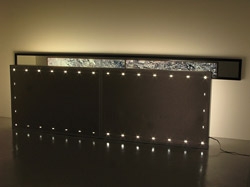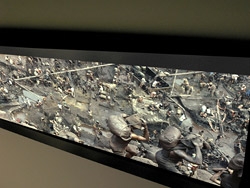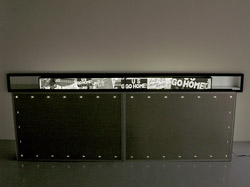The balance between ethics and aesthetics

Text: Matsuura Naomi
Confronted by the deluge of images in the modern world, New York-based Chilean artist Alfredo Jaar remains steadfastly skeptical of their use as spectacle. Taking images that offer a fragment, a snapshot of a certain scene, and probing the real story behind those images is the departure point for Jaar’s art practice. Seeing things with his own eyes is of vital importance to Jaar’s work. In 1985, he received a Guggenheim Fellowship, and was given the opportunity to travel to one such certain scene: the gold mines of Serra Pelada, Brazil, where he witnessed firsthand and recorded in a series of photographs the miners’ harsh working conditions.
“I’ve found ways to protect the images to make sure they say what I want them to say, rather than staying on the surface without entering people’s minds. The device of showing them in light boxes through reflections in mirrors is one approach I’ve used repeatedly since the Gold series (1985) of which part is currently on display in the Kenji Taki Gallery (Nagoya). The space between mirror and lightbox is a magical one: shown in the mirror are memories, history, illusion, yourself, other spectators. Mirrors, which only reflect fragments, are symbolic of our relationship with a fragmented history, and fragmented images.”

Gold in the Morning 1985
Two lightboxes with color transparencies, framed mirror

Gold in the Morning (detail)
After Brazil, for Jaar it became essential to experience places in person, following exhaustive research. In 1994, questioning the tardy response of the international community to civil war in Rwanda, he made his way to that country. The unspeakable misery he witnessed there pushed Jaar’s distrust of images to the limit. Conveying the wretchedness of Rwanda via pictures seemed impossible, and from Rwanda onward, his use of images grew increasingly radical. At Documenta XI (2002) he eliminated visuals entirely to exhibit Lament of the Images, an installation composed of light and text.
Jaar’s strategy of confirming things with his own eyes gives his work a journalistic aspect. The defining differences between Jaar’s work and that of the journalist are the chosen method of presentation, and the balance of beauty and ethics within the work. In contrast to the directness of journalism and documentary work, Jaar tries to avoid presenting images directly. To understand his works requires the physical effort of reading text, and looking in the mirror. And once viewers comprehend the ethos of the work, and turn their eyes once more to the space in its entirety, they are greeted by beauty, as if to reward that effort.
“It’s almost as if I am a journalist that has infiltrated the art world. I’m always trying to inform people of certain realities that they ignore. I think there is very little difference between the job of a journalist, and that of an artist. Basically it is just the context in which they present their work. Both have aesthetic and ethical elements, and while the proportions of each may vary, neither can be entirely eliminated.”
Jaar has consistently based his work on events in the here and now, but his new offerings at the Kenji Taki Gallery (Tokyo) at first glance appear to deal with events in the past, using poetry by A-bomb survivor Kurihara Sadako, who passed away in 2005, plus photographs documenting the student radicalism that swept much of the West and Japan in the ’60s, and social movements such as May Day.


I’ll always keep singing (For Kurihara Sadako) 2008
Two lightboxes with B/W and color transparencies, framed mirror
Photos courtesy the artist and Kenji Taki Gallery
“This new work alludes to the present day, in the sense that one, this sort of social movement is virtually non-existent in Japan today, and two, women still have lower status in Japanese society. I am a poetry reader, so whenever I go to a place, I read some of its poetry. Kurihara Sadako’s poems are beautiful, and prompt the reader to ponder the identity of Japanese women. She was a strong, vocal activist, a type of Japanese woman unfamiliar to me. Hopefully there will be more and more women like her. The images show crowds of male activists, and inside the crowd, a single female activist that could be her, Kurihara. This work pays homage to Kurihara Sadako, and encourages a critical mindset in people. Here also I show the images reflected in a mirror. I use mirrors to integrate the surrounding environment, and the viewer, into the work. The viewer gazes at the mirror from various angles in an attempt to see what is shown there. In the process their own face is reflected, and the faces of other viewers…they realize that they too can become part of this reality.”
There are moments when history, or a social problem occurring somewhere far away, takes on a sense of reality, placing us in the mind of the party concerned. Even when we see events day to day taking place throughout the world in the newspaper, or on television, really we see them as spectators. One could say that as soon as they take the form of text or sound as news, they become past events, in other words “history” of no direct connection to ourselves. For Alfredo Jaar, going to where those events are taking place to witness them for himself may be a way of taking on history and social problems as his own. For us, his work offers a tangible sense of these phenomena, amid a balance of beauty and ethics.
When asked about his next move, Jaar replies that he never knows.
“I’m an artist who is not afraid to say ‘I don’t know.’ Artists should live in uncertainty. It is from uncertainty that they are able to find something, and express it.”
2008.7.23
Alfredo Jaar
Born 1956 in Santiago. Moved to the US in 1882; lives and works in New York. Jaar has been producing works steeped in politics since the 1980s. For his first solo exhibition in Japan in eight years he showed early works at Kenji Taki Gallery in Nagoya and new works at the gallery’s Tokyo branch (2008). He also did solo shows in 2008 at Spazio Oberdan + Hangar Bicocca (Milano) and Galerie Lelong (Paris).
www.alfredojaar.net
